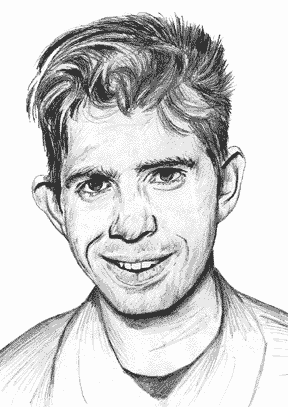INTERVIEW
On Generation X
Jonathan Hoenig Of CapitalistPig
by John Sweeney and Bruce Faber
Generation X: You love 'em, you hate 'em, or you are 'em. Generation X, the generation after the Baby Boomers, are finally at the stage in their lives that they have money to trade with. Trader Jonathan Hoenig, whom Forbes called "the voice of finance for Generation X," hosts an investment radio show aimed at GenXers called "CapitalistPig." He also writes a monthly financial column, makes frequent television appearances, writes newsletters on the Internet, and in general speaks on the limitless opportunity available in trading and investing for Generation X. Not only that, Hoenig, who is 23, has been trading since his teens and is active both on the Mid-American Exchange for futures and through electronic brokers in equities. He has also written a book, Greed Is Good: The Capitalist Pig Guide To Investing, which, curiously, is a conventional, if irreverent, step-by-step to building your portfolio. Through it all, Jonathan speaks to his listeners with candor you'd expect over beer and pretzels at your local bar. Interim Editor John Sweeney and Staff Writer Bruce Faber interviewed Jonathan Hoenig via telephone on August 26, 1999, asking him, among other things, why he prefers commodities over stocks, why he believes that open outcry is on its way out, the difference between investing and trading and why it's important for GenXers, and why his heroes are Karl Marx, Hugh Hefner, and the character "Gordon Gekko" from the movie Wall Street.

ILLUSTRATION BY CARL GREEN
Hi, Jon. Let's get started.
Excellent! I am psyched about this interview. I've honestly enjoyed your magazine for a long time.
That's good to hear.
You know, you have your little stack of mail on your desk and STOCKS & COMMODITIES is at the top of the stack. It's like a little piece of candy that comes in the mail each month.
Are you a technician?
I am. For a long time, I wanted to believe in fundamental analysis, that it actually worked. But then I started learning about technical analysis. I have integrated a lot of technical analysis into my trading. I'm like a CQG addict. You can't get me off of it!
How did you get started in the markets?
I was always interested in trading, and interested in money. Growing up in the 1980s, when Ivan Boesky and Mike Milken, the go-go age, were all the rage of the day, certainly influenced me. I knew I wanted to get into the business. I started investing and doing some trading on my own when I was in high school, when I worked at Starbucks.
I take it you bought Starbucks [SBUX]?
That's right.
So when Starbucks hired you, you bought the stock?
I did. For the first time, I was really starting to make my own money. So I bought Starbucks stock on a customer's recommendation, and ended up making quite a buck off of that stock. Not only enough to allow me to open my own brokerage account and begin trading, but enough that I started investing in mutual funds and other types of financial products as well. For me, at that point, there was no turning back. Then it was on up the investment ladder -- stocks, options, and ultimately futures.
What do you feel should be the approach to investing for Generation X? In your book, you talked about starting off with a nice classic pyramid from your cash position and moving on up.
Right. But futures is on the list, if you noticed.
Yeah, we did.
I hate the stigma attached to derivatives. There are numerous excellent ways to add both options and futures into an investment portfolio, especially since a lot of investment these days is in trading and speculation. Options and futures are products designed for speculation. I definitely wanted to write about those in my book and let the readers decide whether those were right for them.
So you took some of the money that you made from buying Starbucks stock and went into mutual funds.
Absolutely. I remember starting at one end of the Barnes and Noble financial books section, starting somewhere near David Dreman and ending up near Marty Zweig, and inhaling everything I could learn about the markets. Ironically, this was in the mid- to late 1990s, when those amazing double-digit returns were racking up. My interest in trading the markets and becoming part of it all myself as a floor trader grew as the Dow Jones Industrial Average (DJIA) grew.
I got more education in 10 minutes on the floor than I got sitting in a classroom for a year. -- Jonathan Hoenig
Excerpted from an article originally published in the December 1999 issue of Technical Analysis of STOCKS & COMMODITIES magazine. All rights reserved. © Copyright 1999, Technical Analysis, Inc.